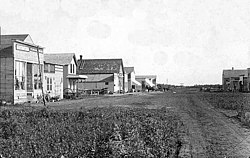Oklee, Minnesota
Oklee | |
|---|---|
 Main Street, 1910 | |
 Location of Oklee, Minnesota | |
| Coordinates: 47°50′15″N 95°51′12″W / 47.83750°N 95.85333°W | |
| Country | United States |
| State | Minnesota |
| County | Red Lake |
| Area | |
• Total | 0.75 sq mi (1.94 km2) |
| • Land | 0.75 sq mi (1.94 km2) |
| • Water | 0.00 sq mi (0.00 km2) |
| Elevation | 1,152 ft (351 m) |
| Population (2020) | |
• Total | 413 |
| • Density | 550.67/sq mi (212.65/km2) |
| Time zone | UTC-6 (Central (CST)) |
| • Summer (DST) | UTC-5 (CDT) |
| ZIP code | 56742 |
| Area code | 218 |
| FIPS code | 27-48202[2] |
| GNIS feature ID | 0648913[3] |
Oklee (/ˈoʊkli/ OH-klee)[4] is a city in Red Lake County, Minnesota, United States on Minnesota State Highway 222. The population was 435 at the 2010 census.[5]
Geography
[edit]According to the United States Census Bureau, the city has a total area of 0.60 square miles (1.55 km2), all land.[6]
History
[edit]A post office called Oklee has been in operation since 1912.[7] The city derives its name from O. K. Lee, the original owner of the town site.[8]
Demographics
[edit]| Census | Pop. | Note | %± |
|---|---|---|---|
| 1920 | 364 | — | |
| 1930 | 377 | 3.6% | |
| 1940 | 414 | 9.8% | |
| 1950 | 494 | 19.3% | |
| 1960 | 529 | 7.1% | |
| 1970 | 536 | 1.3% | |
| 1980 | 536 | 0.0% | |
| 1990 | 441 | −17.7% | |
| 2000 | 396 | −10.2% | |
| 2010 | 435 | 9.8% | |
| 2020 | 413 | −5.1% | |
| U.S. Decennial Census[9] | |||
2010 census
[edit]As of the census[10] of 2010, there were 435 people, 195 households, and 110 families residing in the city. The population density was 725.0 inhabitants per square mile (279.9/km2). There were 225 housing units at an average density of 375.0 per square mile (144.8/km2). The racial makeup of the city was 88.3% White, 9.0% Native American, 0.2% Asian, and 2.5% from two or more races. Hispanic or Latino of any race were 0.7% of the population.
There were 195 households, of which 25.6% had children under the age of 18 living with them, 42.6% were married couples living together, 8.7% had a female householder with no husband present, 5.1% had a male householder with no wife present, and 43.6% were non-families. 37.4% of all households were made up of individuals, and 21.1% had someone living alone who was 65 years of age or older. The average household size was 2.23 and the average family size was 2.91.
The median age in the city was 39.3 years. 24.6% of residents were under the age of 18; 6.8% were between the ages of 18 and 24; 24.9% were from 25 to 44; 22.2% were from 45 to 64; and 21.4% were 65 years of age or older. The gender makeup of the city was 50.6% male and 49.4% female.
2000 census
[edit]As of the census[2] of 2000, there were 396 people, 196 households, and 105 families residing in the city. The population density was 603.7 inhabitants per square mile (233.1/km2). There were 229 housing units at an average density of 349.1 per square mile (134.8/km2). The racial makeup of the city was 98.74% White, 1.01% Native American, and 0.25% from two or more races. Hispanic or Latino of any race were 0.25% of the population.
There were 196 households, out of which 26.5% had children under the age of 18 living with them, 42.3% were married couples living together, 9.2% had a female householder with no husband present, and 46.4% were non-families. 44.9% of all households were made up of individuals, and 26.5% had someone living alone who was 65 years of age or older. The average household size was 2.02 and the average family size was 2.85.
In the city, the population was spread out, with 24.7% under the age of 18, 5.8% from 18 to 24, 23.2% from 25 to 44, 19.9% from 45 to 64, and 26.3% who were 65 years of age or older. The median age was 42 years. For every 100 females, there were 90.4 males. For every 100 females age 18 and over, there were 82.8 males.
The median income for a household in the city was $23,214, and the median income for a family was $30,417. Males had a median income of $22,333 versus $18,500 for females. The per capita income for the city was $14,342. About 12.3% of families and 14.7% of the population were below the poverty line, including 27.5% of those under age 18 and 8.1% of those age 65 or over.
Footnotes
[edit]- ^ "2020 U.S. Gazetteer Files". United States Census Bureau. Retrieved July 24, 2022.
- ^ a b "U.S. Census website". United States Census Bureau. Retrieved January 31, 2008.
- ^ "US Board on Geographic Names". United States Geological Survey. October 25, 2007. Retrieved January 31, 2008.
- ^ "Minnesota Pronunciation Guide". Associated Press. Archived from the original on July 22, 2011. Retrieved July 4, 2011.
- ^ "2010 Census Redistricting Data (Public Law 94-171) Summary File". American FactFinder. U.S. Census Bureau, 2010 Census. Retrieved April 23, 2011.[dead link]
- ^ "US Gazetteer files 2010". United States Census Bureau. Archived from the original on January 12, 2012. Retrieved November 13, 2012.
- ^ "Red Lake County". Jim Forte Postal History. Retrieved August 4, 2015.
- ^ Upham, Warren (1920). Minnesota Geographic Names: Their Origin and Historic Significance. Minnesota Historical Society. p. 446.
- ^ "Census of Population and Housing". Census.gov. Retrieved June 4, 2015.
- ^ "U.S. Census website". United States Census Bureau. Retrieved November 13, 2012.
Further reading
[edit]- Oklee Golden Jubilee Historical Committee, The Oklee Community Story. n.c.: Oklee Golden Jubilee Historical Committee, 1960.

